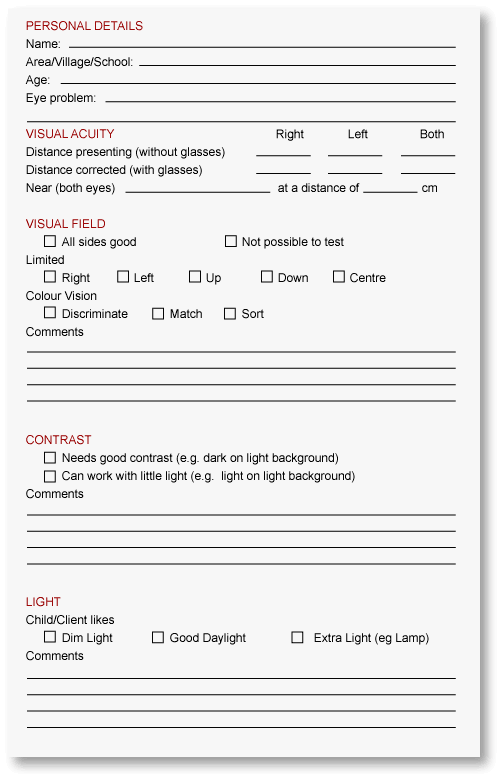
|
|
7 Areas of Visual Skills
Summary of functional assessment procedure
These 19 activities are divided into 7 sections. They are suggestions to test functional vision
Items Ideas to Assess Skills 1. Awareness and attention to details a. Attention
not needed if VA testing is done
use bright object, size of hand
b. Reach
up to 1 metre
use small stones, paper balls
from big to small
centre, left, right...
2. Control of eye movements- tracking
a. Maintain gaze
small objects for rolling- to 4 metres
different contrast
b. Track an object
distance 1 metre
use bright objects
- up and down, side to side, diagonal and near to far
3. Control of eye movements- scanning
a. Shift gaze
distance 1 metre
1 object in each hand
horizontal, vertical
b. Change fixation
distance 3 metres
tester bright object
client small object
near, far, near
4. Discrimination of objects
a. Find object
distance 4-5 metres
familiar, different contrast objects, e.g. kettle
b. follow path
route over path with borders and winding
c. Avoid objects
route with ground obstacles, puddles, branches
d. Identify near and distant objects
near, 1 metre- coin, pencil, knife, spoon, stone
distance- activities, scene
5. Discrimination of details to identify actions and match objects
a. Imitation of body gestures and actions
distance 5 metres
gross movements
b. Facial expressions
distance 2 metres
c. Match size
use coins, or leaves or buttons
6. Discrimination of details in pictures
a. Recognise actions
b. Find objects in a complicated picture
7. Identification and perception of patterns, numbers and words
a. Match abstract figures
b. Match numbers
c. Match shapes with inner details
d. Match words and pictures
Adapted from "Assessment of Low Vision in Developing Countries" in the Low Vision Kit Record the actual response, not what the person says they can do or you think they can do
Make notes on:
- the objects used for the assessment
- how easy or difficult the work was
- the person's comments
- behaviour during the assessment
- distance for each item
- the time taken to finish the activity, for example, 'quick', 'needed a long time', 'slow to respond' or 'scanning slow and random'
- if low vision devices were available and used
Here is an example of a form that can be completed to assess a child
Which is more important for orientation and mobility; seeing details or scanning?
Which is more important for orientation and mobility contrast sensitivity or colour vision?
|
|
| Visual Communication Unit |

